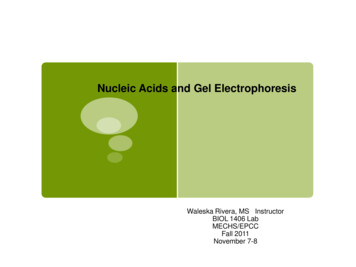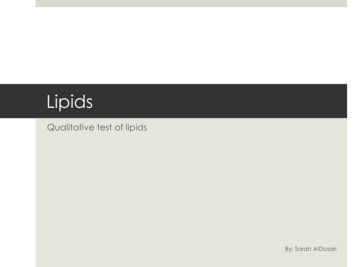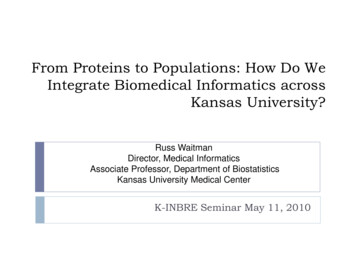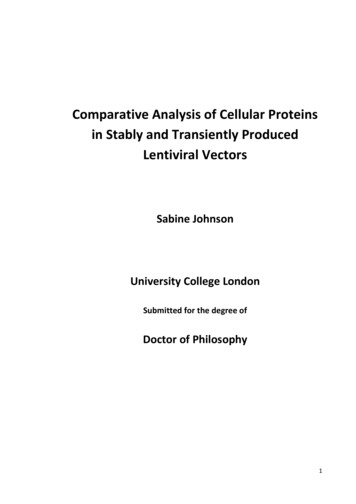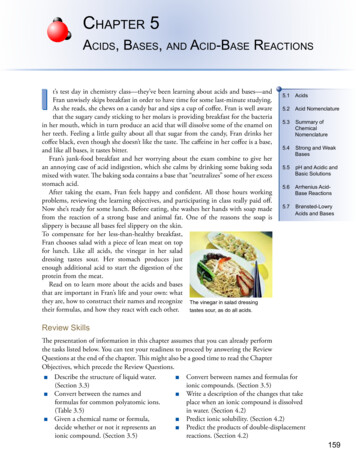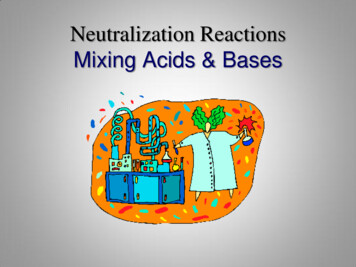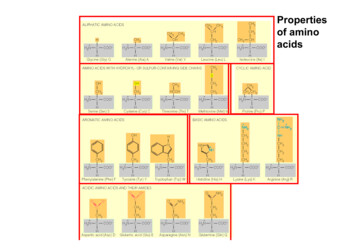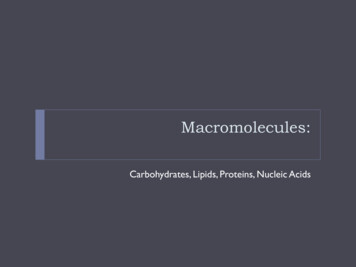
Transcription
Macromolecules:Carbohydrates, Lipids, Proteins, Nucleic Acids
I. Organic CompoundsA. What are organiccompounds?1. Contain carboncovalently bonded toanother carbon2. Found in all livingthings3. Cells are madeup almost entirely ofH2O & organiccompounds
I. Organic CompoundsB. What makes carbonsuch an importantelement?1.2.3.It forms 4 bondsIt forms long chains withitselfIt can form single, double,& triple bonds
I. Organic Compounds
I. Organic CompoundsD. Functional groups1. Special groups ofatoms attached toorganic compounds2. Used to identifyorganic compounds
Macromolecules Many molecules in living things are HUGE ( relatively)These huge molecules are called:Macromolecules “Macro” – giant“Molecule” – two or more atoms put together Macromolecules are the building blocks of living things
Macromolecules Macromolecules are made up of smaller pieces One of these pieces by itself is called a monomer “Mono” - oneMonomer – one unit/building block of a macromoleculePutting many monomers together results in a polymer “Poly” – manyPolymer – many units/building blocks hooked together
Polymer example
MacromoleculesIf 2 molecules have the same chemical formula, butdifferent structures, then they are isomers HHHCOHC2H6OO HHCCHCHHHHHIsomer – a molecule with the same chemical formula butdifferent structure as another molecule
Macromolecules The process of monomers coming together to formpolymers is called polymerizationPolymerization
Macromolecules Putting two or more monomers together is done througha process called dehydration synthesis orcondensation Let’s break that one down De – “removal of”Hydration – “water”Synthesis – “put tegether”So, dehydration synthesis means: The removal of a water molecule to form a new bond
Carbohydrates
Carbohydrates The reverse of a dehydration synthesis reaction is called ahydrolysis, where water is used to break the bondbetween monomers
Kinds of Macromolecules 4 groups of macromolecules found in living things(organic compounds) are: CarbohydratesLipidsProteinsNucleic Acids
Carbohydrates
Carbohydrates Main ideas for carbohydrates: Uses for carbohydratesHow to identify a carbohydrateExamples of carbohydratesChemical tests for carbohydrates
Carbohydrates A carbohydrate is a molecule made up of carbon,hydrogen, and oxygen atoms A carbohydrate will have twice as many hydrogen atomsas oxygen atoms H:O 2:1
Carbohydrates Made up of 3 major groups: MonosaccharidesDisaccharidesPolysaccharidesThe word saccharide means “sugar.” What do you thinkthe words, mono-, di-, and polysaccharide mean?
Carbohydrates Monosaccharides are single sugar molecules Examples: Fructose (fruit sugar), Galactose (milk sugar), Glucose (blood sugar):
III. CarbohydratesA. Monosaccharides1. SimplestCarbohydrates2. Monomers used tobuild larger carbohydrates3. Used for quick energy4. Ratio of C:H:O 1:2:1 CH2O5. C6H12O6
Carbohydrates Putting two or more monosaccharides together is donethrough a process called dehydration synthesis orcondensation Let’s break that one down De – “removal of”Hydration – “water”Synthesis – “put tegether”So, dehydration synthesis means: The removal of a water molecule to form a new bond
Carbohydrates Dehydration synthesis Practice trying to put these two monosaccharides together:
Carbohydrates Dehydration synthesis Practice trying to put these two monosaccharides together:
Carbohydrates Disaccharides are two sugar molecules put together Examples: Sucrose (table sugar – pictured), Lactose (milk sugar), Maltose
Carbohydrates Dehydration synthesis occurs between two glucosemolecules. You know that glucose has a chemical formulaof C6H12O6. How could you figure out the chemicalformula for the new disaccharide formed?
Carbohydrates Dehydration synthesis occurs between two glucosemolecules. You know that glucose has a chemical formulaof C6H12O6. How could you figure out the chemicalformula for the new disaccharide formed? C6H12O6 C6H12O6 - H2O C12H22O11
Carbohydrates Polysaccharides are 3 or more monosaccharides puttogether
III. CarbohydratesC. Polysaccharides1. No formula, but ratio ofH:O always 2:12. Used for energy storagea. Starch – plant storageb. Glycogen – animalstorage3. Examplesa. Cellulose – plant cellwallsb. Chitin – insectexoskeletons,cell walls of fungi
Carbohydrates What about uses for carbohydrates? Living things use these carbohydrate molecules as theirprimary source of energy The breakdown of sugars supplies immediate energy for all cellactivities
Carbohydrates Some foods are high in “carbs.” Have you ever heard of someone trying to “carbo-load”before?What type of person would most likely want to carbo-load?Why would they?
Carbohydrates Testing for carbohydrates How could you find out what carbohydrates are present in asample? Benedict’s Test (blue) If it turns orange you have a monosaccharide, if it turns blue you havea disaccharide, if it turns blue you have a polysaccharideIodine Test (yellow) If it turns yellow you have a monosaccharide, if it turns yellow youhave a disaccharide, if it turns purple you have a polysaccharide
What are the only 3 elements allcarbohydrates are made of?
What is the ratio of H:O in carbohydrates?
What type of carbohydrate is glycogen?
What molecule do animals use to storeenergy?
What is the molecular formula for allmonosaccharides?
Which carbohydrate is found in plant cellwalls?
Proteins
Proteins Main ideas for proteins: What makes up a protein?What are the key parts of an amino acid?How are proteins assembled?What do proteins do?How can we test for proteins?
Proteins What is a protein? A protein is a macromolecule made up of nitrogen, carbon,hydrogen, and oxygen
Proteins Amino acids Monomers of proteinsCompounds of nitrogen atoms, oxygen atoms, carbon atoms,and hydrogen atomsHave an amino group and a carboxyl group Let’s see what they look like
Amino GroupCarboxyl GroupNH2COOHThe R Group refers to the “rest of” the molecule.Amino acids will always look the same except for the R group.There are MANY different R groups.
Proteins are Diverse! To the right, you see manydifferent amino acids thered part is the R group With MANY different Rgroups, there are MANYdifferent possiblecombinations of aminoacids, which means thereare MANY differentproteins
Proteins How do amino acid monomers polymerize to formprotein polymers? In other words, how are proteins puttogether? Dehydration synthesis!
Proteins Combining amino acids with dehydration synthesis: Amino Group always bonds with the Carboxyl GroupPeptide bond: Covalent bond formed between two aminoacids when H2O is removed R – C – N – R OH
Proteins Proteins are called macromolecules for a good reason THEY ARE GIGANTIC! (relatively)The average size for a protein can be well over 250 aminoacids This forms an amino acid chain or a POLYPEPTIDE
Protein These long chains are neatly organized inside living things: Levels of organization: Primary Structure – the chainSecondary Structure – the chain curls into an alpha helix or foldsinto a beta sheetTertiary Structure – alpha helices and beta sheets fold on eachotherQuarternary Structure – large sections of tertiary structures foldover each otherLet’s see what these looks like:
Proteins StructureD. Protein Structure1. Primary (1 )Structurea. Long chain ofamino acids2. Secondary (2 )Structurea. alpha helixb. beta-pleated sheet
III. ProteinsTertiary (3 ) Structure3.a.b.c.Continued folding of polypeptidebeyond secondary structureCaused by attractions between Rgroups of amino acidsCan be fibrous or globularQuaternary (4 ) Structure4.a.b.c.Highest level of protein structureMade of two or more foldedpolypeptides joined togetherMost (but not all) proteins have aquaternary structureDenaturation5.a.Destruction of a proteins naturalshape due to rise in temp orchange in pH
Proteins Remember: with many different R groups, there are manycombinations of amino acids, meaning that there are manydifferent proteins Each type has a specific role!
Proteins What do proteins do?Structural SupportEX: Keratin – hair, nails, rhino horns, turtle shellsCollagen – bone, tendons, ligaments – most abundant in our bodies
Proteins What do proteins do?Enzymes Speed up chemical reactions (catalysts)EX: Sucrase – breaks down sucrose
Proteins What do proteins do? Transport Carry nutrients around bodyEX: Hemoglobin – carries oxygen around body through bloodstream
Proteins What do proteins do? Defense Help protect body against diseaseAnti-bodies
Proteins What do proteins do? Hormones Send signals to cells & organs Insulin – tells cells to take in glucose from blood
Proteins Where can you find proteins? They start inside our cells (where they are made)HairBoneMuscleMeatEggsOrgansLOTS of other locations
Proteins How can you test for a protein? Biuret’s Test Changes to purple in the presence of a protein
Lipids
Lipids Main ideas for lipids: What a lipid is made ofUses for lipidsExamples of lipidsTests to determine if lipids are present
Lipids Lipids Molecules made up of mostly carbon and hydrogen atoms (andsome oxygen atoms too) Nonpolar covalent bonds HydrophobicInsoluble in water Can be identified by the 2 key parts of their assembly: oneglycerol backbone and 3 long carbon chains (fatty acids) Far greater than 2:1 H:O ratio
Lipids Making a lipid: The first key part to a lipid is a glycerol Glycerol serves as the “backbone” of the lipid
Lipids Making a lipid The other key parts to a lipid are 3 fatty acids Long carbon chainsCarboxylGroupCarbon ChainCOOHCar
Lipids 2 kinds of fatty acids: Saturated Unsaturated All single bonds in the carbon chain There are the maximum possiblenumber of hydrogenOne or more double bonds in thecarbon chain There could be more hydrogen Generally considered “bad” for you Solid at room temperatureGenerally considered “better” foryou Straight Liquid at room temperature Kinked (not straight)
Lipids Making a lipid So how do the glycerol and fatty acids come together? Dehydration synthesis
Lipids Dehydration synthesis
LipidsC. Uses in Living Things1. Long-term EnergyStoragea. Fatsb. Oils
LipidsC. Uses in Living Things2. Protectiona. Plantsb. Animals
LipidsC. Uses in Living Things3. Insulationa. Blubber (marinemammals)
What do these guys have in common?
LipidsC. Uses in Living Things4. Hormones (Steroids)a. Testosteroneb. Estrogenc. Cholesterol
IV. LipidsUses in Living ThingsC.Cell (Plasma) Membranes5.a.b.PhospholipidsPolar head, 2 nonpolar tails
Lipids Examples of lipids Meat fatOilWaxesButterGreaseMayo
Lipids Tests to run: The water solubility test Lipids do not mix in water – non lipids doThe brown paper bag test If you put a substance on a paper bag and the bag dried well over time,the substance was a non-lipid. If the bag never looks dry and light canget through it, the substance was a lipid
Carbohydrates Putting two or more monosaccharides together is done through a process called dehydration synthesis or condensation Let’s break that one down De – “removal of” Hydration – “water” Synthesis – “put tegether” So, dehydration synthesis means: The removal of a File Size: 2MBPage Count: 75
